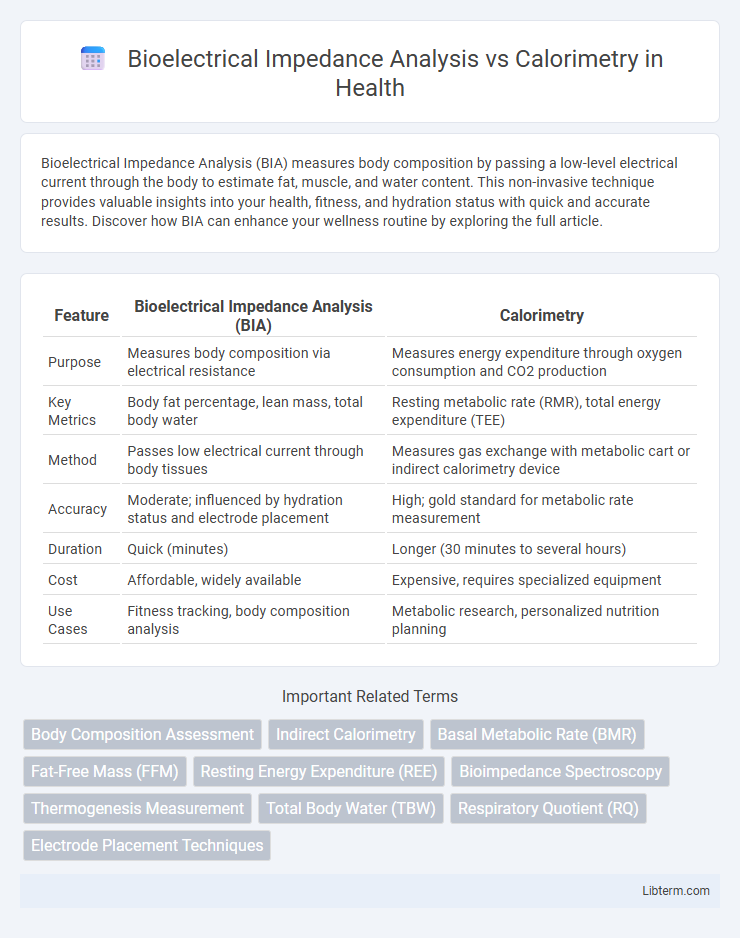Bioelectrical Impedance Analysis (BIA) measures body composition by passing a low-level electrical current through the body to estimate fat, muscle, and water content. This non-invasive technique provides valuable insights into your health, fitness, and hydration status with quick and accurate results. Discover how BIA can enhance your wellness routine by exploring the full article.
Table of Comparison
| Feature | Bioelectrical Impedance Analysis (BIA) | Calorimetry |
|---|---|---|
| Purpose | Measures body composition via electrical resistance | Measures energy expenditure through oxygen consumption and CO2 production |
| Key Metrics | Body fat percentage, lean mass, total body water | Resting metabolic rate (RMR), total energy expenditure (TEE) |
| Method | Passes low electrical current through body tissues | Measures gas exchange with metabolic cart or indirect calorimetry device |
| Accuracy | Moderate; influenced by hydration status and electrode placement | High; gold standard for metabolic rate measurement |
| Duration | Quick (minutes) | Longer (30 minutes to several hours) |
| Cost | Affordable, widely available | Expensive, requires specialized equipment |
| Use Cases | Fitness tracking, body composition analysis | Metabolic research, personalized nutrition planning |
Introduction to Body Composition Analysis Techniques
Bioelectrical Impedance Analysis (BIA) estimates body composition by measuring the resistance of electrical flow through body tissues, providing quick and non-invasive assessments of fat mass, lean mass, and hydration levels. Calorimetry, particularly indirect calorimetry, evaluates energy expenditure by analyzing oxygen consumption and carbon dioxide production, offering precise metabolic rate measurements that indirectly reflect body composition. Both techniques serve complementary roles in body composition analysis, with BIA excelling in convenience and Calorimetry delivering detailed metabolic insights.
What is Bioelectrical Impedance Analysis (BIA)?
Bioelectrical Impedance Analysis (BIA) is a non-invasive method that estimates body composition by measuring the resistance of body tissues to a small electrical current. It provides data on body fat percentage, lean body mass, and total body water by analyzing how easily the current travels through different types of tissues. BIA is commonly used for assessing hydration status and tracking changes in body composition over time.
Fundamentals of Calorimetry in Health Assessment
Calorimetry in health assessment measures energy expenditure by quantifying heat produced during metabolic processes, providing accurate insights into basal metabolic rate and total energy expenditure. Unlike Bioelectrical Impedance Analysis, which estimates body composition through electrical conductivity, calorimetry directly evaluates metabolic activity, making it essential for precise nutritional and physiological evaluations. Indirect calorimetry, a common method, calculates energy use by analyzing oxygen consumption and carbon dioxide production, offering critical data for personalized health management and clinical interventions.
How BIA Measures Body Composition
Bioelectrical Impedance Analysis (BIA) measures body composition by sending a low-level electrical current through the body and detecting the resistance or impedance to the current flow, which varies between lean tissue, fat, and water. Lean muscle and water conduct electricity better than fat due to their higher water content, allowing BIA to estimate body water, fat mass, and lean body mass accurately. In comparison, calorimetry measures energy expenditure by analyzing oxygen consumption and carbon dioxide production but does not directly assess body composition.
Principles Behind Calorimetric Measurements
Calorimetric measurements are based on the principle of quantifying heat exchange associated with metabolic processes to determine energy expenditure. Indirect calorimetry calculates oxygen consumption and carbon dioxide production to estimate metabolic rate, relying on respiratory gas analysis. This method provides precise insights into substrate utilization and energy balance, differentiating it from Bioelectrical Impedance Analysis, which estimates body composition through electrical conductivity.
Accuracy and Reliability: BIA vs Calorimetry
Bioelectrical Impedance Analysis (BIA) offers quick and non-invasive body composition measurements but can be influenced by hydration levels and environmental factors, affecting accuracy and reliability. Calorimetry, especially indirect calorimetry, provides more precise assessments of metabolic rate by directly measuring oxygen consumption and carbon dioxide production, making it the gold standard in metabolic studies. While BIA is convenient for routine use, calorimetry remains superior in accuracy and reliability for detailed metabolic and energy expenditure analysis.
Advantages and Limitations of BIA
Bioelectrical Impedance Analysis (BIA) offers a quick, non-invasive, and cost-effective method for estimating body composition by measuring the resistance of electrical flow through bodily tissues. BIA advantages include ease of use, portability, and suitability for large population studies, but its accuracy can be affected by hydration levels, recent food intake, and electrode placement. Compared to Calorimetry, which provides precise metabolic rate data through oxygen consumption and energy expenditure measurements, BIA is less accurate for assessing resting metabolic rate but more practical for routine body composition monitoring.
Strengths and Weaknesses of Calorimetry
Calorimetry excels in accurately measuring total energy expenditure by directly assessing heat production, providing precise metabolic rate data essential for clinical and research settings. Its limitations include the need for specialized equipment, controlled environments, and longer test durations, which reduce practicality for routine or large-scale use. While highly reliable for metabolic studies, calorimetry is less accessible and more costly compared to methods like Bioelectrical Impedance Analysis.
Clinical and Practical Applications
Bioelectrical Impedance Analysis (BIA) offers a rapid, non-invasive method for estimating body composition, useful in clinical settings for monitoring hydration status and nutritional health. Calorimetry, including indirect calorimetry, provides precise measurements of metabolic rate and energy expenditure, critical for managing metabolic disorders and tailoring nutritional interventions. Both techniques complement each other by delivering essential data for personalized patient care in obesity management, critical illness, and athletic performance optimization.
Choosing the Right Method for Your Needs
Bioelectrical Impedance Analysis (BIA) offers a quick, non-invasive way to estimate body composition by measuring electrical conductivity through tissues, making it ideal for routine fitness assessments and monitoring hydration levels. Calorimetry, including indirect calorimetry, provides precise measurements of metabolic rate and energy expenditure by analyzing oxygen consumption and carbon dioxide production, which is essential for tailored nutrition and metabolic studies. Selecting the right method depends on the desired accuracy, purpose, and resources available: BIA suits general health tracking while calorimetry is preferred for clinical or detailed metabolic evaluations.
Bioelectrical Impedance Analysis Infographic

 libterm.com
libterm.com